Household Harvesting, State Policy, and Migration: Evidence from the Survey of Living Conditions in the Arctic
Abstract
:1. Introduction
2. Background
3. Survey of Living Conditions in the Arctic (SLiCA)
4. Statistical Methods
5. Results
6. Discussion
7. Conclusions
Funding
Institutional Review Board Statement
Informed Consent Statement
Data Availability Statement
Acknowledgments
Conflicts of Interest
Appendix A. Statistical Tests of the Effect of State Policy on Migration Intent
| Variable Name | Definition | Arctic Alaska | Arctic Canada | Greenland | Chukotka |
|---|---|---|---|---|---|
| Dependent variables | |||||
| HH subsistence harvest | Percent of meat and fish from household’s own harvest, grouped: 0 = none, 0.25 = less than half, 0.5 = about half, 0.75 = more than half | 0.449 | 0.455 | 0.356 | 0.375 |
| HH earnings per adult | Total HH wage and self-employment earnings (local currency) per HH member aged 16–64 | 20,630 | 20,718 | 143,213 | 225,946 |
| Migration intent | Have you considered moving away from the community in the past five years? (1 = yes, 0 = no) | 0.444 | 0.282 | 0.351 | 0.381 |
| Respondent characteristics | |||||
| Female | Female respondent | 0.554 | 0.503 | 0.526 | 0.534 |
| Age | Respondent age, in years | 41.8 | 34.7 | 42.2 | 40.2 |
| Age squared | Square of respondent age | 2008 | 1445 | 1989 | 1782 |
| Education level | 10 categories: 0 (no school) through 9 (post-graduate degree) | 4.01 | 3.17 | 2.78 | 3.14 |
| Subsistence skills | Number out of a list of 20 of skills learned while growing up | 11.7 | 8.9 | 19.8 | |
| Disabled | Hampered in daily activities by chronic condition (in Chukotka: self-assessed health status = ‘poor’) | 0.106 | 0.139 | 0.236 | |
| Family ties index | Index of perceived ties and frequency of contact with family members not living in the household | 11.90 | 3.90 | 3.75 | |
| Crime victim | Categories of crime respondent was victimized within past year (0–4) | 0.306 | 0.278 | ||
| Ever lived elsewhere | =1 if ever lived in another community, 0 otherwise | 0.446 | |||
| Household characteristics | |||||
| Indigenous language use | Use of Indigenous language at home (1 = not at all, through 5 = all the time) | 3.26 | 3.75 | 4.70 | 2.42 |
| Adult females in household | Number of females aged 18 and over in the household | 1.09 | 1.09 | 1.01 | 1.24 |
| Adult males in household | Number of males aged 18 and over in the household | 1.20 | 1.18 | 1.10 | 1.35 |
| Teens in household | Number of teens aged 16–17 in the household | 0.196 | 0.421 | 0.128 | 0.256 |
| Elders in household | Number of elders aged 65 and over in the household | 0.230 | 0.131 | 0.153 | 0.040 |
| Non-Indigenous in household | =1 if a non-Indigenous person in the household, 0 otherwise | 0.137 | 0.044 | 0.172 | |
| No men in the household | =1 if no males over 16 in the household, 0 otherwise | 0.126 | 0.146 | 0.161 | 0.133 |
| Children under 16 | Number of children under 16 years of age in the household | 1.76 | 1.41 | 0.95 | 1.19 |
| Pre-school children | Number of children under 5 (under 6 in Canada) in the household | 0.534 | 0.320 | 0.217 | 0.406 |
| Pre-school children, no men | No males over 16 times number of children under 5 (6 in Canada) | 0.063 | 0.036 | 0.012 | 0.019 |
| School-age child | =1 if one or more children aged 6–14 living in the HH, 0 otherwise | 0.403 | |||
| Household size | Number of persons in the household | 5.06 | |||
| Persons per room | Household size divided by number of rooms | 0.320 | |||
| Lone female | Household size = 1 and female respondent | 0.013 | 0.033 | 0.012 | |
| Lone male | Household size = 1 and male respondent | 0.050 | |||
| Multi-generational household | At least three generations in the household | 0.047 | |||
| Household projected harvests | Contribution of individual and household characteristics to projected household harvests | 0.121 | 0.164 | 0.0929 | 0.110 |
| Household projected earnings | Contribution of individual and household characteristics to projected household earnings | 6558 | −9316 | 35,096 | |
| Log household projected earnings | Natural logarithm of household projected earnings | 1.093 | |||
| Place characteristics | |||||
| Total employment | Census employment in community, 2000 (000s) | 0.682 | |||
| Employment change | Percentage change of employment, 1990–2000 | 0.356 | |||
| Regional center | =1 if arctic community population > 1500 | 0.356 | 0.314 | 0.180 | |
| Coastal community | =1 if community is located on coast, 0 otherwise | 0.765 | 0.425 | ||
| Caribou using community | =1 if caribou regularly available to a community | 0.404 | |||
| Salmon using community | =1 if salmon regularly available to a community | 0.247 | 0.148 | ||
| Food cost index | Food cost relative to Ottawa (Canada DIAND Food Cost Survey) | 1.79 | |||
| Percent old housing | Percent of housing in the community built before 1970 | 0.141 | 0.134 | ||
| Nunavik region | Nunavik region relative to Nunatsiavut region | 0.219 | |||
| Nunavut region | Nunavut Territory relative to Nunatsiavut region | 0.596 | |||
| Inuvialuit region | Inuvialuit region relative to Nunatsiavut region | 0.087 | |||
| Log of full-time jobs | Natural logarithm of number of full-time jobs located in the community | 5.48 | |||
| Per-capita jobs | Employment divided by population | 0.217 | |||
| Per-capita private jobs | Private sector employment divided by population | 0.238 | |||
| Pct. Indigenous population | Indigenous people as percent of the population | 0.859 | |||
| Log of population | Natural logarithm of population (2002 Chukotka, 2004 Greenland) | 7.47 | 6.82 | ||
| Industrial community | =1 if established as a Soviet-era industrial town | 0.173 | |||
| Whaling community | =1 if whaling carried out in the community | 0.271 | |||
| Reindeer herding | =1 if reindeer herding carried out in the community | 0.501 | |||
| Log of total earnings | Natural logarithm of total earnings in the community, 2004 | 12.41 | |||
| Year-round air service | =1 if the community has year-round air service | 0.650 | |||
| Per-capita harvest earnings | Earnings from wild food harvests per person, 2004 | 3.23 | |||
| Percent of year iced-in | Percentage of time sea ice prevents water access to community | 0.147 | |||
| Grade 12 | =1 if local school through 12th grade | 0.680 | |||
| Town | =1 for residents of communities with population of 10,000 to 20,000 | 0.283 | 0.0716 | ||
| Iced-in regional center | Regional center times percentage iced in | 0.064 | |||
| Place projected harvests | Contribution of place characteristics to projected household harvests | 0.104 | 0.290 | 0.146 | 0.142 |
| Place projected earnings | Contribution of place characteristics to projected household earnings | 11,384 | 31,016 | 35,096 | |
| Log place projected earnings | Natural logarithm of place projected earnings | 0.836 | |||
| Variable Name | Arctic Alaska | Arctic Canada | Greenland | Chukotka |
|---|---|---|---|---|
| Constant | −0.561 | 0.0052 | −0.343 | −0.962 |
| (−3.46) | (0.02) | (−0.90) | (−3.92) | |
| Female | 0.0315 | −0.0748 | 0.0894 | −0.0559 |
| (0.79) | (−4.45) | (2.63) | (−1.84) | |
| Age | 0.0108 | 0.0064 | 0.0153 | −0.00678 |
| (1.81) | (2.13) | (2.63) | (−1.09) | |
| Age squared | −0.000162 | −5.58 × 10−5 | −0.000165 | 0.000022 |
| (−2.41) | (−1.54) | (−2.37) | (0.29) | |
| Education level | 0.0319 | −0.0128 | −0.0258 | 0.0459 |
| (1.54) | (−2.49) | (−1.70) | (3.90) | |
| Subsistence skills | 0.0135 | 0.023508 | 0.00616 | |
| (3.24) | (5.71) | (3.96) | ||
| Disabled | −0.0814 | −0.112 | 0.0147 | |
| (−1.58) | (−2.54) | (0.43) | ||
| Family ties index | 0.0248 | −0.0064 | 0.0191 | |
| (3.09) | (−0.40) | (1.11) | ||
| Indigenous language use | 0.0644 | 0.0202 | −0.0075 | 0.0468 |
| (3.83) | (2.41) | (−0.33) | (4.14) | |
| Adult females in household | 0.0675 | 0.0742 | 0.0001 | 0.0264 |
| (2.51) | (5.48) | (0.005) | (1.39) | |
| Adult males in household | 0.0417 | 0.0315 | 0.0437 | 0.0633 |
| (1.50) | (2.23) | (1.67) | (3.39) | |
| Teens in household | 0.0171 | 0.0799 | 0.0502 | 0.0038 |
| (0.46) | (5.59) | (1.23) | (0.13) | |
| Elders in household | 0.0753 | 0.111 | 0.122 | 0.036 |
| (1.72) | (4.55) | (2.60) | (0.55) | |
| Non-Indigenous in household | 0.00575 | −0.0696 | 0.0360 | |
| (0.14) | (−0.88) | (1.10) | ||
| No men in household | −0.141 | −0.174 | −0.232 | 0.0004 |
| (−1.94) | (−5.24) | (−3.88) | (0.01) | |
| Pre-school children | −0.0756 | 0.0240 | 0.0010 | −0.0408 |
| (−2.81) | (0.99) | (0.03) | (1.69) | |
| Pre-school children, no men | −0.0969 | −0.0571 | 0.0001 | −0.0013 |
| (−1.60) | (−1.10) | (0.00) | (0.01) | |
| Children under 16 | 0.0229 | −0.0111 | −0.0017 | 0.0394 |
| (1.82) | (−1.24) | (−0.11) | (2.48) | |
| School-age child | 0.0320 | |||
| (1.30) | ||||
| Household size | 0.0132 | |||
| (2.50) | ||||
| Total employment | −0.206 | |||
| (−2.04) | ||||
| Employment change | −0.0413 | |||
| (−0.52) | ||||
| Log of full-time jobs | −0.0834 | |||
| (−4.86) | ||||
| Per-capita jobs | 0.734 | |||
| (2.56) | ||||
| Per-capita private jobs | 0.688 | |||
| (2.83) | ||||
| Regional center | 0.136 | −0.0251 | 0.0405 | −0.433 |
| (0.84) | (−0.75) | (0.502) | (−4.98) | |
| Percent Indigenous population | 0.382 | |||
| (2.52) | ||||
| Food cost index | 0.164 | |||
| (1.77) | ||||
| Logarithm of population | −0.355 | 0.208 | ||
| (−2.92) | (6.87) | |||
| Log of total earnings | 0.226 | |||
| (2.27) | ||||
| Per-capita harvest earnings | −0.00714 | |||
| (−1.82) | ||||
| Percent of year iced-in | 0.234 | |||
| (1.96) | ||||
| Coastal community | 0.0972 | −0.0551 | ||
| (2.05) | (−1.25) | |||
| Caribou using community | 0.142 | −0.117 | ||
| (reindeer in Chukotka) | (3.15) | (−3.76) | ||
| Salmon using community | 0.109 | 0.110 | ||
| (2.28) | (2.47) | |||
| Whaling community | 0.0970 | |||
| (2.01) | ||||
| Industrial community | −0.0049 | |||
| (−0.10) | ||||
| Nunavik region | −0.184 | |||
| (−2.59) | ||||
| Nunavut region | −0.219 | |||
| (−2.70) | ||||
| Inuvialuit region | −0.250 | |||
| (−3.78) | ||||
| Town | −0.406 | |||
| (−5.62) | ||||
| Sigma | 0.362 | 0.476 | 0.414 | 0.239 |
| (23.31) | (55.38) | (27.49) | (22.38) | |
| Observations | 622 | 4295 | 938 | 447 |
| Log Likelihood | −377.1 | −3378 | −664.6 | −131.2 |
| Variable Name | Arctic Alaska (U.S. Dollars) | Arctic Canada (Cdn. Dollars) | Greenland (Danish Kronur) | Chukotka (Log Earnings, Rubles) |
|---|---|---|---|---|
| Constant | −18.2 | −33.5 | −733.8 | 1.950 |
| (−2.52) | (−4.41) | (−4.93) | (1.05) | |
| Female | −2.79 | 3.89 | 1.15 | −0.406 |
| (−1.61) | (7.33) | (0.09) | (−1.82) | |
| Age | 0.679 | 0.549 | 16.92 | 0.134 |
| (2.50) | (5.93) | (6.55) | (2.55) | |
| Age squared | −0.01 | −0.00479 | −0.200 | −0.001 |
| (−2.89) | (−4.35) | (−6.57) | (−1.95) | |
| Education level | 4.38 | 2.32 | 29.53 | 0.231 |
| (4.78) | (14.23) | (5.59) | (2.73) | |
| Subsistence skills | 25.90 | 1152.3 | −0.056 | |
| (0.14) | (0.81) | (−4.76) | ||
| Disabled | −2.21 | −55.63 | −0.512 | |
| (−0.93) | (−3.52) | (−2.03) | ||
| Family ties index | 0.652 | 9.539 | 0.028 | |
| (1.87) | (1.58) | 0.22) | ||
| Indigenous language use | −0.249 | −1.953 | −29.10 | −0.255 |
| (−0.33) | (−7.43) | (−4.06) | (−3.07) | |
| Adult females in household | 459.0 | −2915.1 | 12105 | −0.072 |
| (0.39) | (−7.04) | (1.14) | (−0.52) | |
| Adult males in household | −927.7 | −3953.7 | −35473 | −0.260 |
| (−0.75) | (−8.84) | (−2.88) | (−1.93) | |
| Teens in household | −1962.4 | −4591.5 | −41921 | −0.891 |
| (−1.23) | (−10.42) | (−2.68) | (−3.86) | |
| Elders in household | −4394.6 | 1693.2 | −25690 | 1.201 |
| (−2.22) | (2.26) | (−1.35) | (2.33) | |
| Non-Indigenous in household | 5125.4 | −14166 | 0.054 | |
| (3.13) | (−0.54) | (0.22) | ||
| No men in household | −5471.4 | −6372.3 | −96251 | −0.394 |
| (−1.72) | (−6.32) | (−4.27) | (−1.03) | |
| Pre-school children | 1709.4 | −39.6 | 100580 | 0.072 |
| (0.66) | (−0.02) | (2.21) | (0.40) | |
| Pre-school children, no men | 735.4 | 572.46 | 5770.9 | −0.063 |
| (1.33) | (2.07) | (1.01) | (−0.09) | |
| Children under 16 | −1533.6 | −2963.9 | −13687 | 0.099 |
| (−1.30) | (−3.88) | (−1.04) | (0.84) | |
| School-age child | −666.1 | |||
| (−0.86) | ||||
| Household size | 1550.4 | |||
| (9.48) | ||||
| Total employment | −13.43 | |||
| (−3.01) | ||||
| Employment change | −4.12 | |||
| (−1.17) | ||||
| Log of full-time jobs | −997.5 | |||
| (−1.85) | ||||
| Per-capita jobs | 64297 | |||
| (7.11) | ||||
| Per-capita private jobs | −451.9 | |||
| (−0.06) | ||||
| Regional center | 28,078 | 1398.9 | 12,967 | −1.594 |
| (3.97) | (1.35) | (0.43) | (−2.44) | |
| Percent Indigenous population | 7496.9 | |||
| (1.55) | ||||
| Food cost index | 6228.1 | |||
| (2.15) | ||||
| Logarithm of population | −102,030 | 0.414 | ||
| (−2.15) | (1.87) | |||
| Log of total earnings | 94,617 | |||
| (2.44) | ||||
| Per-capita harvest earnings | −1698.9 | |||
| (−1.11) | ||||
| Percent of year iced-in | 6583.2 | |||
| (0.14) | ||||
| Coastal community | 1680.9 | 0.530 | ||
| (0.80) | (1.65) | |||
| Caribou using community | 5207.3 | −0.652 | ||
| (reindeer in Chukotka) | (2.65) | (−2.82) | ||
| Salmon using community | 2012.8 | −0.793 | ||
| (0.97) | (−2.41) | |||
| Whaling community | −2.100 | |||
| (−5.88) | ||||
| Industrial community | −0.444 | |||
| (−1.10) | ||||
| Nunavik region | 6558.1 | |||
| (2.96) | ||||
| Nunavut region | 5009.1 | |||
| (1.98) | ||||
| Inuvialuit region | 2855.5 | |||
| (1.40) | ||||
| Town | −0.500 | |||
| (−0.93) | ||||
| Sigma | 16,298 | 16,546 | 129,480 | 1.762 |
| (32.55) | (92.30) | (32.70) | (26.30) | |
| Observations | 594 | 4490 | 690 | 424 |
| Log Likelihood | −6054 | −48,453 | −7499 | −806.3 |
| Variable Name | Arctic Alaska | Arctic Canada | Greenland | Chukotka |
|---|---|---|---|---|
| Household projected earnings | 2.471 × 10−5 | 2.836 × 10−5 | 1.275 × 10−6 | −0.0703 |
| (log earnings in Chukotka) | (1.88) | (5.81) | (1.00) | (0.71) |
| Household projected harvests | −1.416 | −6.905 | 1.472 | 0.5760 |
| (−2.34) | (−6.57) | (1.83) | (0.62) | |
| Place projected earnings | −1.354 × 10−5 | 1.900 × 10−5 | −8.524 × 10−6 | −0.6280 |
| (log earnings in Chukotka) | (−2.10) | (3.11) | (−1.74) | (−4.96) |
| Place projected harvests | −3.146 | −1.697 | 4.035 | 1.8103 |
| (−4.31) | (−2.67) | (3.52) | (2.22) | |
| Female | 0.134 | −0.269 | 0.050 | 0.883 |
| (1.07) | (−4.52) | (0.50) | (4.74) | |
| Age | −0.0252 | −0.0054 | −0.0240 | −0.040 |
| (−5.50) | (−2.44) | (−5.72) | (−5.42) | |
| Education level | 0.150 | |||
| (2.43) | ||||
| Disabled (poor health) | 0.792 | |||
| (3.89) | ||||
| Lone female | 0.747 | −0.290 | 0.174 | |
| (4.11) | (−0.97) | (0.29) | ||
| Lone male | 0.565 | |||
| (1.60) | ||||
| Adult females in household | 0.299 | −0.102 | ||
| (5.21) | (−1.15) | |||
| Adult males in household | 0.134 | −0.025 | ||
| (3.07) | (−0.26) | |||
| Teens in household | 0.315 | −0.066 | 0.447 | |
| (5.35) | (−0.48) | (2.19) | ||
| Elders in household | 0.151 | 0.265 | −0.118 | |
| (0.82) | (2.91) | (−0.94) | ||
| Multi-generational household | −0.335 | |||
| (−1.14) | ||||
| Non-Indigenous in household | 0.343 | |||
| (1.71) | ||||
| No men in the household | −0.510 | 0.354 | ||
| (−3.52) | (1.44) | |||
| Pre-school children, no men | −0.334 | −0.376 | ||
| (−2.32) | (−0.79) | |||
| Children under 16 | −0.0394 | 0.0263 | ||
| (−0.91) | (0.53) | |||
| Pre-school children | 0.0899 | 0.122 | −0.478 | |
| (1.64) | (1.11) | (−3.55) | ||
| School-age child | 0.0328 | |||
| (0.57) | ||||
| Crime victim | 0.173 | 0.146 | ||
| (2.14) | (2.34) | |||
| Persons per room | 0.130 | |||
| (2.06) | ||||
| Ever lived elsewhere | 0.278 | |||
| (2.31) | ||||
| Percent old housing | 0.784 | 0.795 | ||
| (3.00) | (1.36) | |||
| Food cost index | 0.478 | |||
| (5.01) | ||||
| Log of population | −0.253 | |||
| (−2.54) | ||||
| Industrial community | 1.497 | |||
| (4.99) | ||||
| Reindeer herding | −0.268 | |||
| (−1.57) | ||||
| Percent of year iced-in | −1.052 | |||
| (−2.32) | ||||
| Year-round air service | 1.547 | |||
| (2.77) | ||||
| Grade 12 | −0.374 | |||
| (−0.95) | ||||
| Town | 0.658 | |||
| (2.46) | ||||
| Iced-in regional center | −0.400 | |||
| (−1.91) | ||||
| Constant | 0.875 | −0.586 | 2.170 | 0.596 |
| (2.34) | (−1.69) | (1.20) | (0.44) | |
| Observations | 530 | 4210 | 928 | 447 |
| Log Likelihood | −318.7 | −2312.3 | −538.5 | −176.6 |
| Restricted Log L. | −364.4 | −2508.7 | −601.6 | −293.6 |
| Chi Squared | 91.4 | 392.7 | 126.2 | 23 |
References
- Nuttall, M.; Berkes, F.; Forbes, B.; Kofinas, G.; Vlassova, T.; Wenzel., G. Hunting, Herding, Fishing, and Gathering: Indigenous Peoples and Renewable Resource Use in the Arctic. In Arctic Climate Impact Assessment—Scientific Report; Cambridge University Press: Cambridge, UK, 2010; pp. 649–690. [Google Scholar]
- Sakakibara, C. Kiavaliakkikput Agviq (Into the Whaling Cycle): Cetaceousness and Climate Change among the Inupiat of Arctic Alaska. Ann. Assoc. Am. Geogr. 2010, 100, 1003–1012. [Google Scholar] [CrossRef]
- James, F.; Smit, B.; Wandel, J.; Allurut, M.; Shappa, K.; Ittusarjuat, H.; Qrunnut, K. Climate Change in the Arctic: Current and Future Vulnerability in Two Inuit Communities in Canada. Geogr. J. 2008, 174, 45–62. [Google Scholar]
- Dinero, S. “The Lord Will Provide”: The History and Role of Episcopalian Christianity in Nets’aii Gwich’in Social Development Arctic Village, Alaska. Indig. Nations Stud. J. 2003, 4, 3–28. [Google Scholar]
- Berger, T.R. Northern Frontier, Northern Homeland; Indian and Northern Affairs: Ottawa, ON, Canada, 1977. [Google Scholar]
- Rasmussen, R.O. Resource Changes and Community Response: The Case of Northern Fisheries. In Canada’s and Europe’s Northern Dimensions; Dey, A., Nuttall, M., Eds.; University of Oulu Press: Oulu, Finland, 2009; pp. 85–94. [Google Scholar]
- Thornton, T.F. Alaska Native Subsistence: A Matter of Cultural Survival. Cult. Surviv. Q. 1998, 22, 29–34. [Google Scholar]
- Case, D. Subsistence and Self-Determination: Can Alaska Natives Have a More Effective Voice? Colo. Law Rev. 1989, 60, 1009–1034. [Google Scholar]
- Kruse, J.; Poppel, B.; Abryutina, L.; Duhaime, G.; Martin, S.; Poppel, M.; Kruse, M.; Ward, E.; Cochran, P.; Hanna, V. Survey of Living Conditions in the Arctic (SliCA). In Barometers of Quality of Life around the Globe: How Are We Doing? Møller, V., Huschka, D., Michalos, A.C., Eds.; Social Indicators Research Series; Springer: Dordrecht, The Netherlands, 2009; Volume 33, pp. 107–134. [Google Scholar]
- Singh, I.; Squire, L.; Strauss, J. The Basic Model: Theory, Empirical Results, and Policy Conclusions. In Agricultural Household Models: Extension, Application and Policy; Singh, I., Squire, L., Strauss, J., Eds.; Johns Hopkins University Press: Baltimore, MD, USA, 1986; pp. 17–47. [Google Scholar]
- Huskey, L.; Berman, M.; Hill, A. Leaving Home, Returning Home: Migration as a Labor Market Choice for Alaska Natives. Ann. Reg. Sci. 2004, 38, 75–92. [Google Scholar] [CrossRef]
- Greenwood, M. Internal Migration in Developed Countries. In Handbook of Population and Family Economics; Rosenzweig, M., Stark, O., Eds.; Elsevier: Amsterdam, The Netherlands, 1997; pp. 647–720. [Google Scholar]
- Birger, P.; Kruse, J. The Importance of a Mixed Cash- and Harvest Herding Based Economy to Living in the Arctic: An Analysis Based on the Survey of Living Conditions in the Arctic (SliCA). In Quality of Life in the New Millenium: Advances in Quality-of-Life Studies, Theory and Research; Møller, V., Huscka, D., Eds.; Social Indicators Research Series; Springer: Dordrecht, The Netherlands, 2009; Volume 35, pp. 27–42. [Google Scholar]
- Chance, N. Subsistence Research in Alaska: Premises, Practices, and Prospects. Hum. Organ. 1987, 46, 85–89. [Google Scholar] [CrossRef]
- Wolfe, R.; Walker, R. Subsistence Economies in Alaska: Productivity, Geography, and Developmental Impacts. Arct. Anthropol. 1987, 24, 56–81. [Google Scholar]
- Langdon, S.J. Contemporary Alaska Native Economies; University Press of America: New York, NY, USA, 1986. [Google Scholar]
- Usher, P. The Household as an Economic Unit in Arctic Aboriginal Communities, and Its Measurement by Means of a Comprehensive Survey. Soc. Indic. Res. 2003, 61, 175–202. [Google Scholar] [CrossRef]
- Stammler, F. Reindeer Nomads Meet the Market: Culture, Property and Globalization at the End of the Land; Halle Studies in the Anthropology of Eurasia; Litverlag: Muenster, Germany, 2005; Volume 6. [Google Scholar]
- Ulvevadet, B.; Klokov, K. Family-Based Reindeer Herding and Hunting Economies, and the Status and Management of Wild Reindeer/Caribou Populations; Centre for Saami Studies, University of Tromsø: Tromsø, Norway, 2004. [Google Scholar]
- Langdon, S.J. The Integration of Cash and Subsistence in Southwest Alaska Yup’ik Eskimo Communities. Senri Ethnol. Stud. 1991, 30, 269–291. [Google Scholar]
- Condon, R.G.; Collings, P.; Wenzel, G. The Best Part of Life: Subsistence Hunting, Ethnicity, and Economic Adaptation among Young Adult Inuit Males. Arctic 1995, 48, 31–46. [Google Scholar] [CrossRef]
- Goldsmith, S. The Remote Rural Economy of Alaska; Institute of Social and Economic Research: Anchorage, AK, USA, 2007. [Google Scholar]
- Berman, M.; Nicolson, C.; Kofinas, G.; Tetlichi, J.; Stephanie Martin, S. Adaptation and Sustainability in a Small Arctic Community: Results of an Agent-Based Simulation Model. Arctic 2004, 57, 401–414. [Google Scholar] [CrossRef] [Green Version]
- Knapp, G.; Huskey, L. Effects of Transfers on Remote Regional Economies: The Transfer Economy in Rural Alaska. Growth Chang. 1988, 19, 25–39. [Google Scholar] [CrossRef]
- Forbes, B.; Stammler, F.; Kumpula, T.; Meschtyb, N.; Pajunen, A.; Kaarlejärvi., E. High Resilience in the Yamal-Nenets Social-Ecological System, West Siberian Arctic, Russia. Proc. Natl. Acad. Sci. USA 2009, 106, 22041–22048. [Google Scholar] [CrossRef] [Green Version]
- Harrison, G. Alaska’s Constitution: A Citizen’s Guide, 4th ed.; Alaska Legislative Affairs Agency: Juneau, AK, USA, 2002. [Google Scholar]
- Public Law 92-203. Alaska Native Land Claims Settlement Act (ANCSA) (18 December 1971). Available online: https://www.govinfo.gov/content/pkg/STATUTE-85/pdf/STATUTE-85-Pg688.pdf#page=1 (accessed on 18 June 2021).
- Alaska v. Native Village of Venetie Tribal Government, 522 U.S. 520 (1998): (ALASKA v. NATIVE VILLAGE OF VENETIE TRIBAL GOVERNMENT (96-1577) 101 F.3d 1286, Reversed). Available online: https://supreme.justia.com/cases/federal/us/522/520/ (accessed on 18 June 2021).
- Public Law 96-487. Alaska National Interest Lands Conservation Act (ANILCA). (2 December 1980). Available online: https://www.govinfo.gov/content/pkg/STATUTE-86/pdf/STATUTE-86-Pg1027.pdf (accessed on 18 June 2021).
- Public law 92-522. Marine Mammal Protection Act (MMPA) (October 21, 1972). Available online: https://www.govinfo.gov/content/pkg/STATUTE-86/pdf/STATUTE-86-Pg1027.pdf (accessed on 18 June 2021).
- Huntington, H.P. Wildlife Management and Subsistence Hunting in Alaska; University of Washington Press: Seattle, WA, UUA, 1992. [Google Scholar]
- Berger, T. Village Journey: The Report of the Alaska Native Review Commission; Hill and Wang: New York, NY, USA, 1985. [Google Scholar]
- Freeman, M.; Wein, E.; Keith, D. Recovering Rights: Bowhead Whales and Inuvialuit Subsistence in the Western Canadian Arctic; University of Alberta Press: Edmonton, AB, Canada, 1992. [Google Scholar]
- Nunavut Wildlife Management Board. The Nunavut Wildlife Harverst Study. Available online: https://www.nwmb.com/en/publications/harvest-study/1824-156-nwhs-report-2004-156-0003 (accessed on 25 August 2020).
- Heleniak, T.; Holzlehner, T.; Khlinovskaya, E. Der große Exodus: Demographische Trends an Russlands nördlicher Peripherie (The Great Exodus: Demographic Trends in Russia’s Northern Periphery). Osteuropa 2011, 61, 371–386. [Google Scholar]
- Klokov, K. Reindeer Husbandry in Russia. Int. J. Entrep. Small Bus. 2007, 4, 726–784. [Google Scholar] [CrossRef]
- Lyck, L.; Taagholt, J. Greenland—Its Economy and Resources. Arctic 1987, 40, 50–59. [Google Scholar] [CrossRef]
- Dahl, J. Identity, Urbanization, and Political Demography in Greenland. Acta Boreal. 2010, 27, 125–140. [Google Scholar] [CrossRef]
- De Jong, G. Expectations, Gender, and Norms in Migration. Popul. Stud. 2000, 54, 307–319. [Google Scholar] [CrossRef]
- Manski, C. The Use of Intentions Data to Predict Behavior: A Best-Case Analysis. J. Am. Stat. Assoc. 1990, 85, 934–940. [Google Scholar] [CrossRef]
- Ajzen, I.; Fishbein, M. Attitude-Behavior Relations: A Theoretical Analysis and Review of Empirical Research. Psychol. Bull. 1977, 84, 888–918. [Google Scholar] [CrossRef]
- Poppel, B.; Kruse, J.; Duhaime, G.; Abryutina, L. SLiCA Results; Institute of Social and Economic Research: Anchorage, AK, USA, 2007. [Google Scholar]
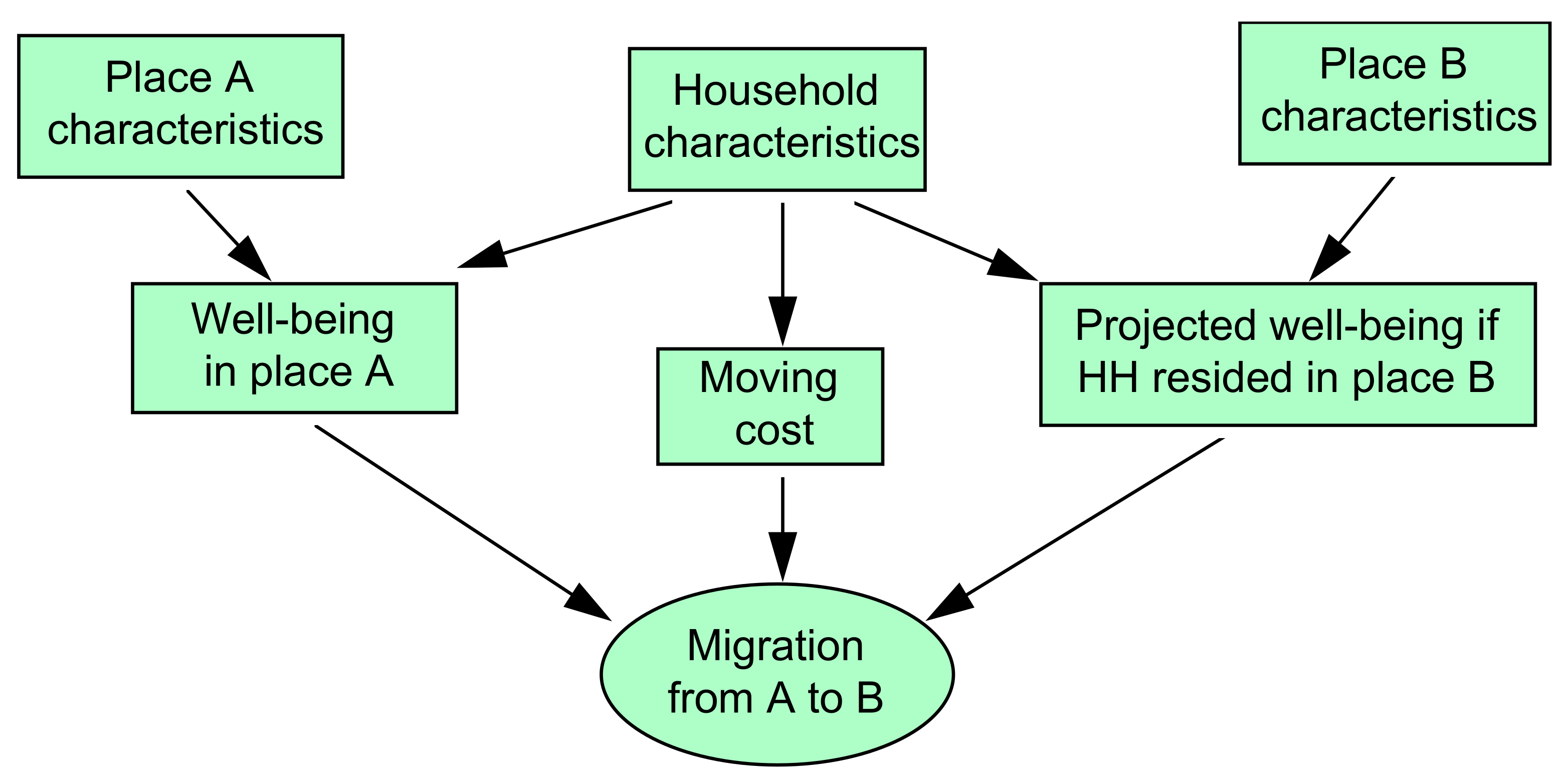
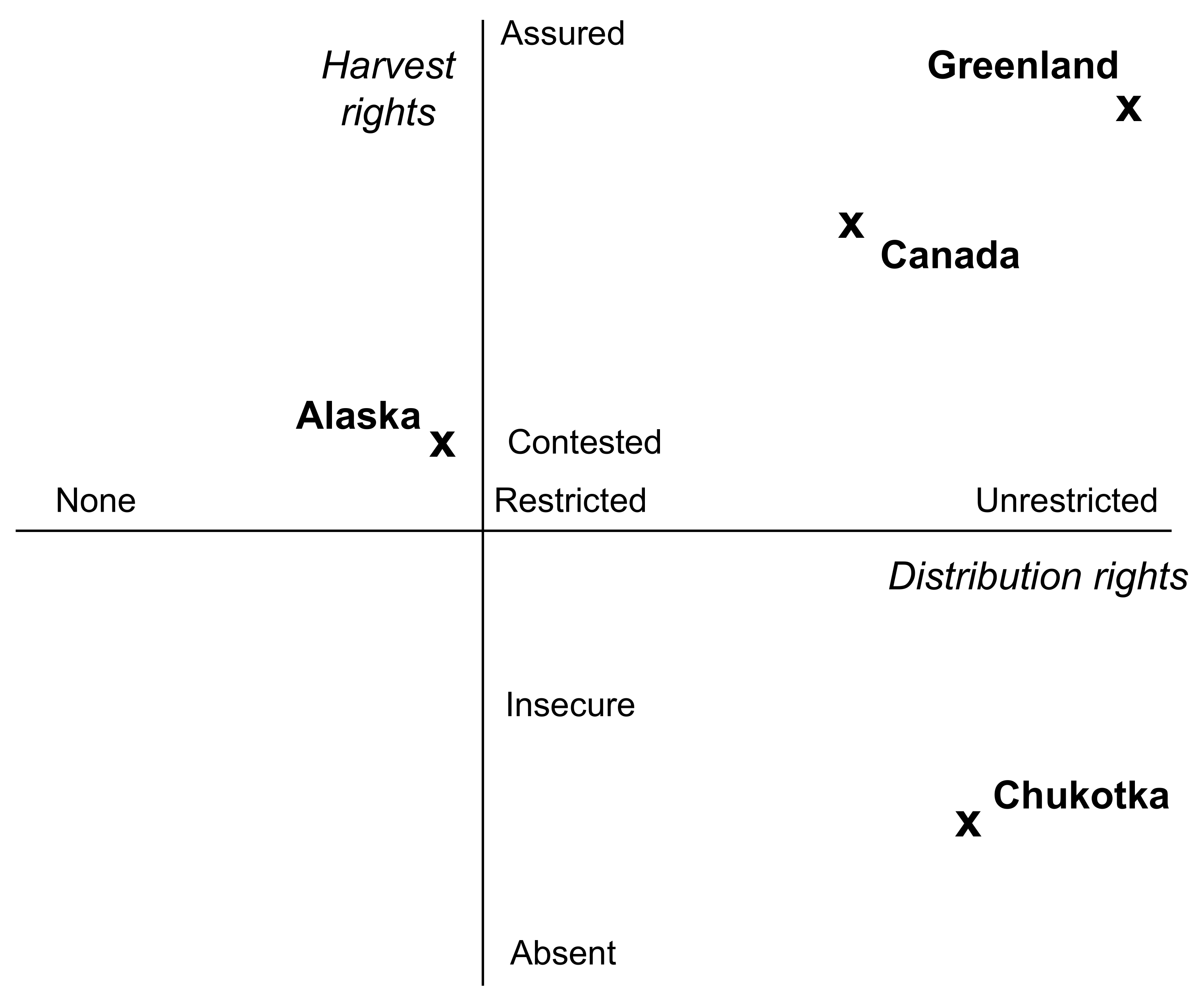
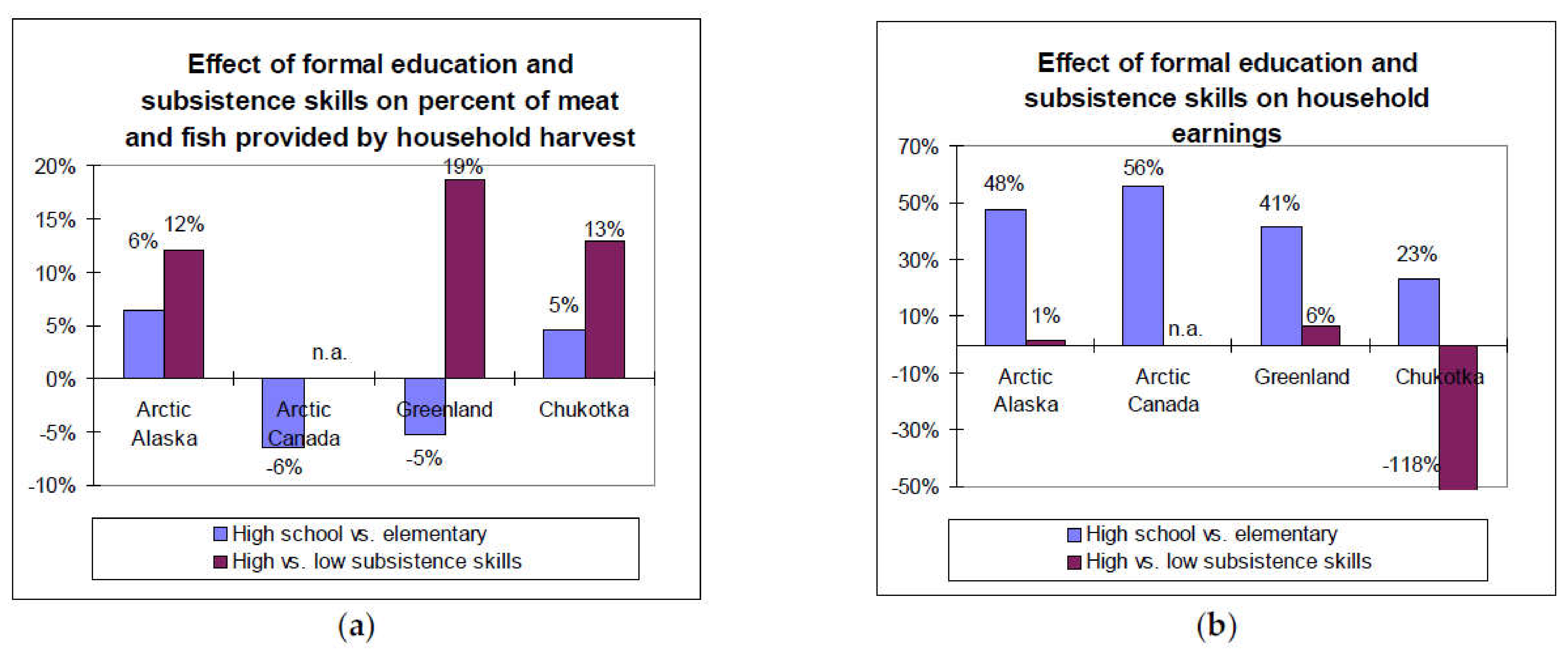
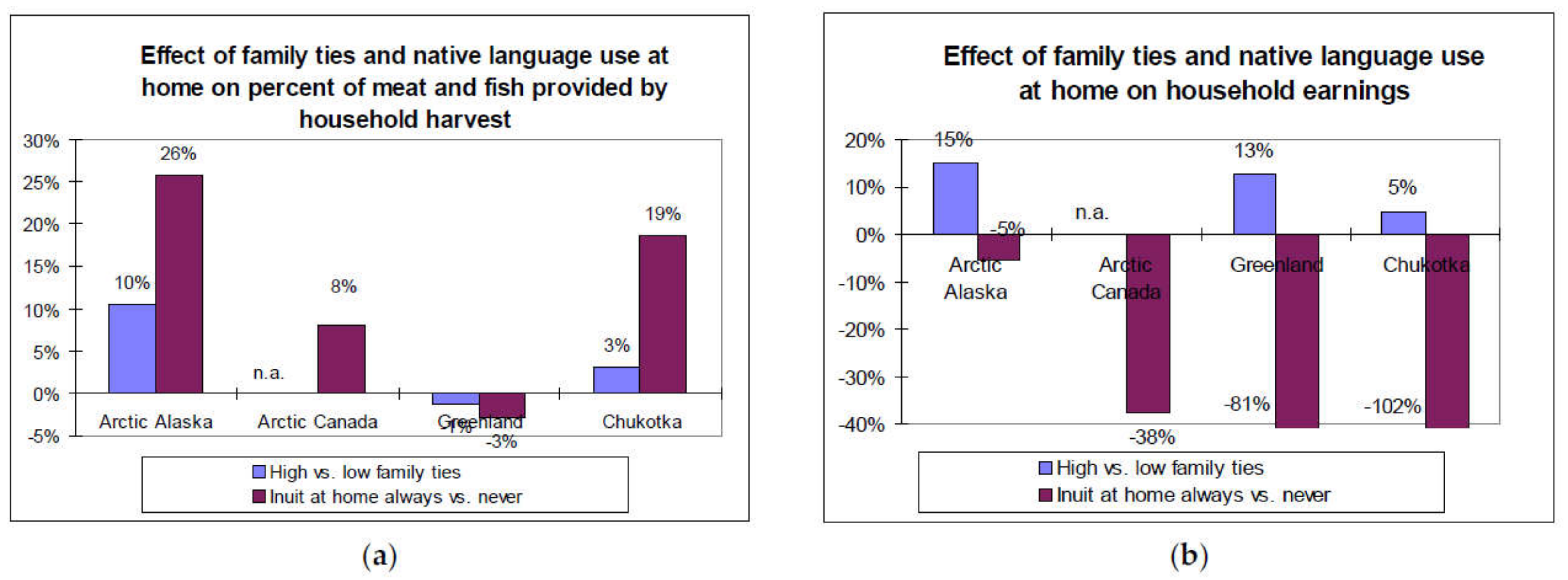
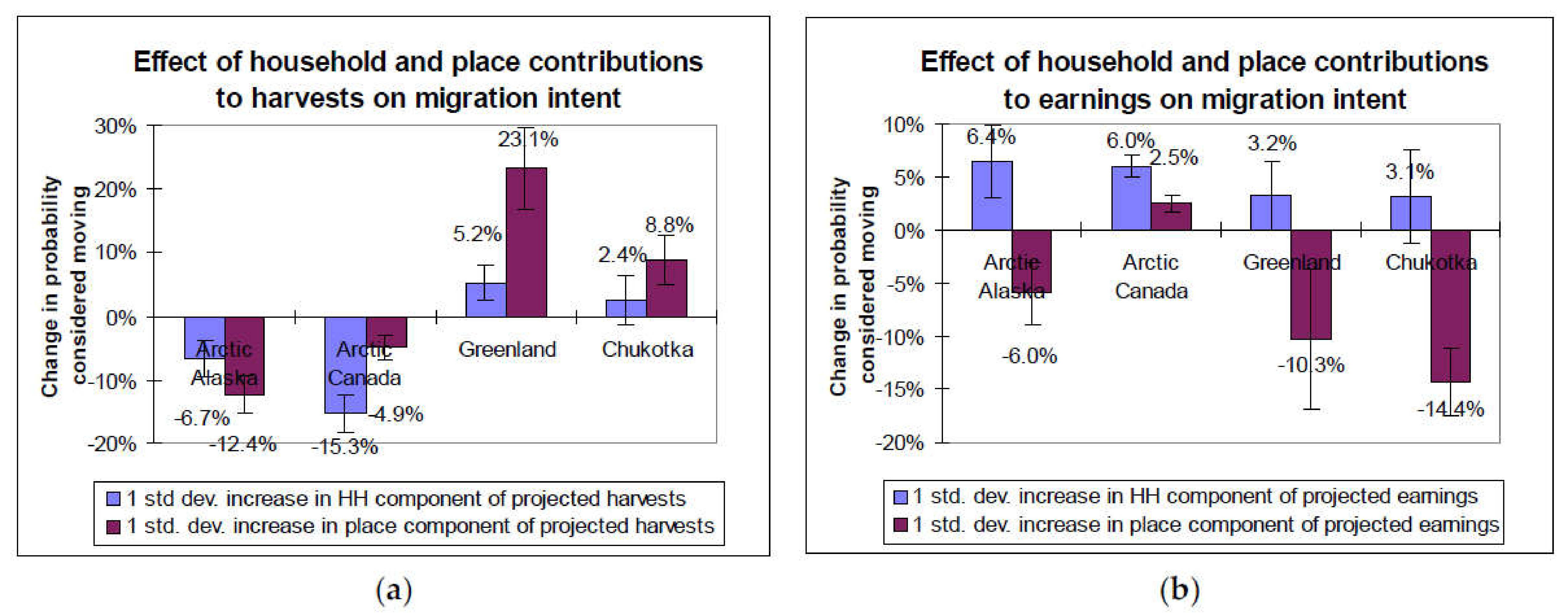
| Population Characteristic | Alaska | Arctic Canada | Greenland | Chukotka |
|---|---|---|---|---|
| Households relying on traditional foods a | ||||
| More than half of meat and fish consumed | 61% | 39% | 40% | 28% |
| More than half from own household harvest | 36% | n.a. | 21% | 17% |
| Average household earnings per worker b | $18,446 | $18,834 | $20,099 | $2415 |
| Preferred ways of making a living: c | ||||
| Harvesting, herding, or processing traditional foods | 8% | n.a. | 30% | 32% |
| Working a wage job | 15% | n.a. | 56% | 40% |
| Both traditional and wage work | 77% | n.a. | 14% | 28% |
| Respondent considered moving away from home community during the past 5 years d | 44% | 28% | 35% | 38% |
Publisher’s Note: MDPI stays neutral with regard to jurisdictional claims in published maps and institutional affiliations. |
© 2021 by the author. Licensee MDPI, Basel, Switzerland. This article is an open access article distributed under the terms and conditions of the Creative Commons Attribution (CC BY) license (https://creativecommons.org/licenses/by/4.0/).
Share and Cite
Berman, M. Household Harvesting, State Policy, and Migration: Evidence from the Survey of Living Conditions in the Arctic. Sustainability 2021, 13, 7071. https://doi.org/10.3390/su13137071
Berman M. Household Harvesting, State Policy, and Migration: Evidence from the Survey of Living Conditions in the Arctic. Sustainability. 2021; 13(13):7071. https://doi.org/10.3390/su13137071
Chicago/Turabian StyleBerman, Matthew. 2021. "Household Harvesting, State Policy, and Migration: Evidence from the Survey of Living Conditions in the Arctic" Sustainability 13, no. 13: 7071. https://doi.org/10.3390/su13137071
APA StyleBerman, M. (2021). Household Harvesting, State Policy, and Migration: Evidence from the Survey of Living Conditions in the Arctic. Sustainability, 13(13), 7071. https://doi.org/10.3390/su13137071





